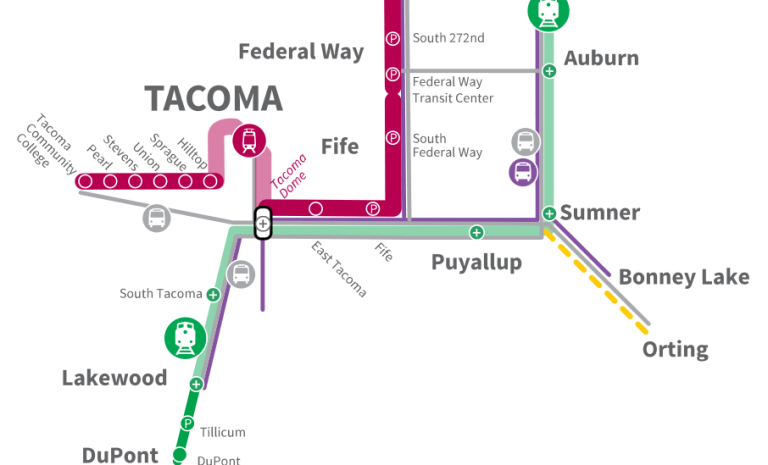The Sound Transit 3 Draft Plan is out for public comment (please take the survey). The following analysis and commentary puts this plan in perspective for Pierce County and Tacoma. ST3 is a 25-year regional transit capital and operating measure, starting in 2017, funded by a suite of three taxes, pending approval by voters in November.
In Pierce County, by far the largest capital investment is in extending regional light rail 9.7 miles from Federal Way to Tacoma Dome Station. Sound Transit estimates the capital outlay to be roughly $2.5 billion (in 2014 dollars). Light rail connecting Tacoma to Federal Way is scheduled for completion in 2033 and would serve a projected ~40,000 riders/day, providing a ~30-minute trip to SeaTac Airport and a 68-minute trip between Tacoma Dome and Westlake Station in Downtown Seattle. The next largest project is a 4.4-mile extension of Tacoma Link to Tacoma Community College (TCC) at a cost of $478 million. Tacoma Link to TCC is scheduled for completion in 2041 with projected ridership at ~15,000 riders/day, spread across six additional stations at TCC, Pearl St, Stevens St, Union Ave, Sprague Ave, and “Hilltop” Stations.
Turning to Sounder, a Sounder extension of 7.8 miles from Lakewood to Dupont, including a station in Tillicum, would cost roughly $300 million and service between 1,000 and 1,500 riders a day and include parking. The next largest project would be capital investments to improve access to Sounder Stations at a cost of $243 million. Additional easements to provide new trips on Sounder would have to be negotiated with Burlington Northern, but have in the past cost roughly $75 million each.
But what about people living today?
The effect of putting so much funding into Link and Sounder in Pierce County is that those projects skew the benefits of the program towards the middle and end of the 25-year period. Transit riders alive today in Pierce County will not benefit from the program as currently designed. In fact, many of them will be at the end of their working careers or no longer with us.
Yes, connecting Tacoma to regional light rail is important. Ridership projections support the project, and future operating costs of less than $3 a passenger justify its construction. But increases and improvements to Sounder service on the other hand are entirely amorphous and are generally undefined in both their costs and ridership. What I do know about expansions of Sounder service is if those trips are not met with improvements to local transit service and non-motorized connections, they mean the provision of low frequency peak commuter service, where planners will insist that parking structures are needed to provide access to the system. Parking is the antithesis of transit investments based in equity. It benefits only those people who drive, and are therefore more affluent, and it takes away from funding that could be used for service or infrastructure to make transit work more efficiently.
“It makes no difference to provide additional buses and trains to the Central Puget Sound if Pierce County does not have the resources to feed those passengers into the regional system.” – Chris Karnes
What would help to spread out the benefits to both current living residents and transit riders would be to nix planned parking expansions and add in funding for some targeted local bus service to connect residents with regional employment centers and connecting regional transit during peak commute hours. Regional commuter service in Pierce County needs to be better served by higher frequency feeder service to ensure optimal ridership and community access. It makes no difference to provide additional buses and trains to the Central Puget Sound if Pierce County does not have the resources to feed those passengers into the regional system. We would essentially not be running on all cylinders. Making pedestrian improvements a quarter-mile from Sounder stations, bike improvements within a half-mile of stations, as is Sound Transit’s policy, is simply not going to cut it in Pierce County.
The light rail Spine was defined in the 2014 Long Range Plan by the Sound Transit Board as including a connection between Tacoma Dome Station and Tacoma Mall. Tacoma’s two Regional Growth Centers as defined by the Puget Sound Regional Council are Downtown Tacoma and Tacoma Mall. It makes sense to include a high capacity transit study to connect the two centers. Whether that connection should be made via Tacoma Link or Central Link technology could be determined in the study and a range of possible alignments could be looked at.
What is not acceptable is the concept of waiting until 2041 for a 4.4-mile Tacoma Link extension to TCC. This is streetcar. It is not elevated. There are no tunnels. The are minimal engineering issues. The capital cost per new passenger is very low and the operating cost is again below $3 a passenger, as with Tacoma to Federal Way. It makes no sense to require 25 years to complete this project when similar projects are designed and constructed in Seattle in 8 years or less. Additionally, Tacoma is going to need Tacoma Link to TCC to act as a feeder to support regional light rail and Sounder ridership. I implore Sound Transit to move this project up further in project phasing for completion prior to the opening service date for Tacoma-Federal Way light rail in 2033.
Learn more about Sound Transit 3 at soundtransit3.org.
Chris Karnes a native of Tacoma and well known local writer behind the Tacoma Transit blog.



